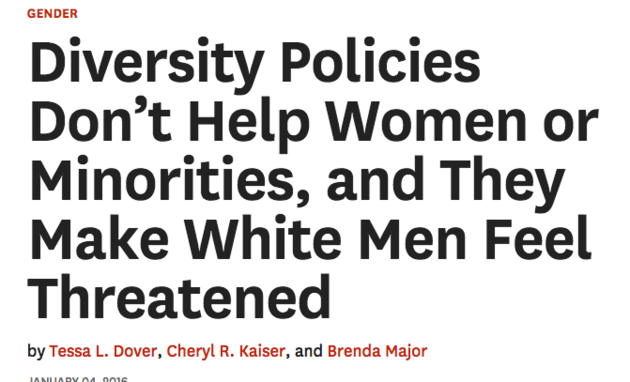[ad_1]
Here’s how you know diversity is not something most businesses take seriously: They spend more time talking about the issue — crafting diversity mission statements, conducting bias trainings — than actually doing anything about it. The message is, even though there aren’t many women or people of color at the top of our company, we do totally care about getting better!
That message is more than just disingenuous, it actually can make things worse for minorities and women, notes a provocative new piece published Monday on the Harvard Business Review’s website.
The article’s title is discouraging: “Diversity Policies Don’t Help Women or Minorities, and They Make White Men Feel Threatened.” Yet buried within the piece, which cites a wide body of research on diversity initiatives, is a heartening message, one that the authors echoed in a phone call with The Huffington Post: Companies can make themselves more diverse.

Harvard Business Review
Businesses must enact real strategies — beyond marketing tools, the authors of the piece told HuffPost. “Give goals to the people in charge of hiring. Check up on those goals,” Tessa Dover, co-author of the HBR piece and a researcher in social psychology at the University of California, Santa Barbara, said by phone Monday. Research suggests that one of the ways to truly achieve diversity is to hold leaders accountable, she added.
Businesses need to treat diversity problems the same way they would treat, say, a drop in profits — all hands on deck to fix the issue immediately. Hold people accountable, question current practices and measure everything. No self-respecting public company would hold “profits training,” then sit back and hope individuals make things better. Yet so many of them offer “bias training,” as though telling workers they have a tendency to unconsciously believe harmful stereotypes is all you need to do to fix the issue.
It’s hardly a new notion that there’s a lack of women or people of color (or women of color) at the top — or even working at — many of the nation’s leading companies. The situation is so bad that Twitter couldn’t even seem to find a person of color or a woman to head up its diversity efforts, recently announcing that Jeffrey Siminoff, a white man, would take on the role. The company has more men named Peter (three of them), than women (one) on its board of directors, btw.
Indeed, by some measures, the business world’s diversity situation is actually getting worse. The percentage of African-American men who hold board seats has actually fallen over the past decade, according to a recent survey. When the CEO of TJX Companies steps down this month, there will be only 20 female CEOs on the S&P 500.
If diversity policies aren’t backed by real strategic efforts, the results are not good. The authors of the HBR piece — experimental psychologists from UC Santa Barbara and the University of Washington — cite a body of research that shows that diversity policies can lead to fewer minorities getting hired and, perhaps worse, give companies cover for wriggling out of discrimination lawsuits.
“Currently, diversity initiatives’ strongest accomplishment may actually be protecting the organization from litigation,” they write.
The article’s authors cite other academics’ work on the effectiveness of diversity programs. Their own research has focused on how diversity policies can alter perceptions of how workers are treated. In a recent paper, they found that the presence of a diversity policy makes white males more anxious about fair treatment. They have more research forthcoming on how Latinos perceive diversity programs.
The authors also pointed to the need for good data and research on what works. Currently there isn’t much.
“It’s not that diversity policies are useless, it’s that they have to be grounded in science and evaluated to ensure they’re actually making a difference,” Carissa Romero — a partner at Paradigm, a diversity consulting group that works with tech companies like Pinterest, Slack and Airbnb — told HuffPost.
Tech stalwart Intel, for example, has concrete, measurable goals around diversity in hiring. For 2015, the company said it wanted 40 percent of new hires to be women or people of color, and it exceeded that goal. Its CEO has been vocal on its aims, and the company is trying different ways to achieve its goals, including doubling referral bonuses for employees who bring in diverse new hires.
While many other tech companies say they are committed to hiring more diverse candidates, few have taken action is such a measurable way.
Intel is “showing real improvement,” Joelle Emerson, Paradigm’s founder and CEO, told HuffPost. When asked about other measurable, successful attempts by a company to diversify, Emerson also pointed to efforts at Google, which was able to retain more women after lengthening maternity leave.

Intel
HuffPost has written in the past about a small Chicago company that’s overhauled its interview process specifically to encourage more diversity — an effort that’s paying off.
Still, good examples of what’s working are hard to come by.
“I think one big problem is there isn’t a lot of research done in real organizations to mark the impact of specific diversity policies,” Emerson said. “There should be tons of these examples over time, but organizations haven’t been good at measuring data, or have touted the amazing change they’ve experienced, when the data don’t really seem to bear that out.”
In other words: We need less talk and more research.
window.modulousQueue.add(function()
waitForGlobal(‘htmlAdWH’, function()
var adsDiv = document.querySelector(‘#adtech_sharebox_260x60’);
adsDiv.removeAttribute(‘id’);
adsDiv.reloadCount = 0;
var adId = ‘93415647’;
try adId; catch(e)
var args = [‘260′, ’60’];
htmlAdWH(adId, args[0], args[1], ‘fc’, adsDiv);
if (typeof debugadcode == ‘function’) debugadcode(‘AdTech’, placement: ‘sharebox_260x60’, mnid: adId, adsDiv);
jQuery(document).on(‘reloadAd’, function(ev, elem)
if (elem && !elem.contains(adsDiv)) return;
var refreshRate = 1;
adsDiv.reloadCount++;
if (adsDiv.reloadCount % refreshRate == 0 && typeof adsReloadAd === ‘function’) adsReloadAd(adsDiv);
);
adSetInView(‘0’);
);
);
+ipt>
[ad_2]
Source link






















